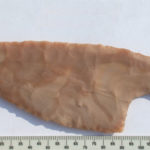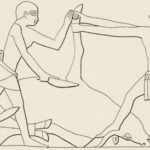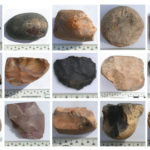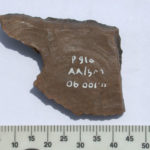By Tim Stevens, Lithics Analyst, and Brian V. Hunt

Flint blade from Giza
Many people think of stone tools as strictly Stone Age technology. The fact that people used chert and other stone for tools is what defines prehistory as the Stone Age. This has led to an under-appreciation of the role of stone tools in sophisticated, literate societies, such as that of Old Kingdom Egypt (2575-2134 BC).
To date, our specialists have examined over 33,500 flint artifacts (flint and chert are geologically distinct but “flint” is often used to refer to objects made from chert) from the Lost City of the Pyramids. Chert can be shaped into very effective tools and its presence in huge quantities on the desert surface made it a natural resource for the pyramid builders.
The Bronze-Age Egyptians’ introduction of metals and other materials certainly changed the relative importance of chert, but it continued to be used during the Old Kingdom and later. Chert is perhaps so common that archaeologists sometimes ignore this simple material in favor of artifacts like pots, which are familiar because we still use pottery, and inscribed sealings because hieroglyphic texts speak more directly than material like chert.
GPMP specialists consider all material valuable to our analysis. The occupants of the Lost City not only used chert in a wide variety of situations, domestic and industrial, but it was also a raw material integral to economic networks extending far beyond the Giza site.
Composition and use

Tomb scene: butchering with a flint knife
Chert is a very fine crystalline material often found in limestone. Geologists think that at Giza it formed as deposits on the desert surface from dissolved limestone or from another as yet unidentified source.
Chert differs from other materials formed of silicon dioxide (silicas such as glass, quartz, opal, and agate). Its crystal structure is so fine that it allows the chert to be flaked into pieces which are not only strong, but retain razor-sharp cutting edges. This differs from quartz, in which large crystals allow only crude edges to be formed.
Two stories
There are two kinds of chert at Giza and each has its own implications for social and economic activity.
- Locally abundant, poorer-quality raw material (knapped by Giza inhabitants for immediate use and then discarded).
- Imported, good quality raw material (acquired and distributed in the form of refined tools requiring preservation and maintenance).
Local Industry

Chert cores from Giza
The first industry is numerically more significant. The most common type of chert artifact at Giza is the simple flake, which ancient toolmakers removed from a larger core using a hammer stone.
It takes no more than a few seconds to produce a viable cutting edge from a chert pebble once some basic skills are acquired. These flakes are used for cutting, scraping, trimming, etc., and their usefulness is not inhibited by the crudeness of their manufacture.
Many of the pieces we’ve excavated appear to have been used; the edges show small flake removals known as “edge damage.” Other pieces have evidence of retouching to strengthen or re-shape the edge and are classed “flake tools.”
The examples of this group are made of local chert, found as pebbles in or on the desert surface or possibly quarried in small amounts from the great quarries on the Giza plateau.
This material is not of particularly good quality because it is naturally quite coarse and does not flake well. Or, as a result of desert weathering, it is liable to split unpredictably when struck. This combination of features seems to have dictated the types of artifacts that the inhabitants produced from local chert.
Imported industry
The second flint industry at Giza was comprised of good quality chert from sources outside of Giza or sources that have not yet been identified at Giza.
These types of chert occur naturally at Giza but in negligible quantities. But we do not find cores of these materials at the site, which further suggests that the settlement inhabitants imported tools and partially finished cores, possibly from sites like Abu Roash, just north of Giza.
This imported chert was used to produce:
- Bifaces (flaked on both faces)
- Triangular scrapers (usually dark chert)
- Blades and blade tools (usually pale pinkish-brown or light grey)

Rough tool from the Giza settlement
The production of blades, blade tools, and bifaces are difficult tasks, even for modern knappers. Ancient producers would have been skilled artisans with a good knowledge of the raw material and the technology required to produce the artifact types we find as exotic (imported) material at Giza.
The strong edges produced from these materials were more suitable for repeated scraping of things like animal hides. They were also more amenable for use in composite tools, such as a sickle or knife, because they did not snap as easily as the inferior chert did when used.
Whilst the imported chert is less significant quantitatively, its presence suggests three things:
- There were economic networks in which chert was an important commodity.
- There were specialists in chert mining and manufacture working at sites economically connected to Giza.
- Similar, or even perhaps the same, technicians operated at Giza itself.
Implications
It seems reasonable to suggest that chert blades may have been imported in bundles as raw material, and the bifaces as partially worked blanks. The absence of cores of exotic chert suggests that the tools were imported, but we do not yet know whether they were transported as raw material or finished tools.
We find distinctive flakes from the retouching of blade tools and scrapers and the thinning of bifaces distributed across the settlement site in varying quantities. They were formed from the initial refinement of raw material or from the inhabitants’ maintenance of used pieces.
One area where flakes from good tools were common is the courtyard of the Royal Administration Building (RAB). The ancient Giza workers may have refined or maintained some tools for distribution from the RAB, a structure possibly associated with a centralized distribution system of the royal house (as indicated by other artifacts). It is conceivable that someone controlled access to good quality tools in that these were not as disposable as tools made from local chert.

Sharpening a flint knife
We also find good quality blade tools, bifacial knives, and waste flakes in another area in relatively large quantities, where sealings are also abundant. It is possible that the control over good tools extended to their distribution only to workers of higher status or skill. It is worth noting that almost no chert of the good, imported type occur north of the Wall of the Crow, where a scrappy local chert assemblage predominates.
Conclusions
The presence of a vibrant flint industry at Old Kingdom Giza again shows that even in a sophisticated age of metal and writing, the ancient Egyptians made use of all available technologies to achieve domestic and industrial ends. The greater abundance of imported chert in the Royal Administration Building and the Western Town areas of the pyramid settlement reinforces the emerging picture of higher-status occupants in these areas.
